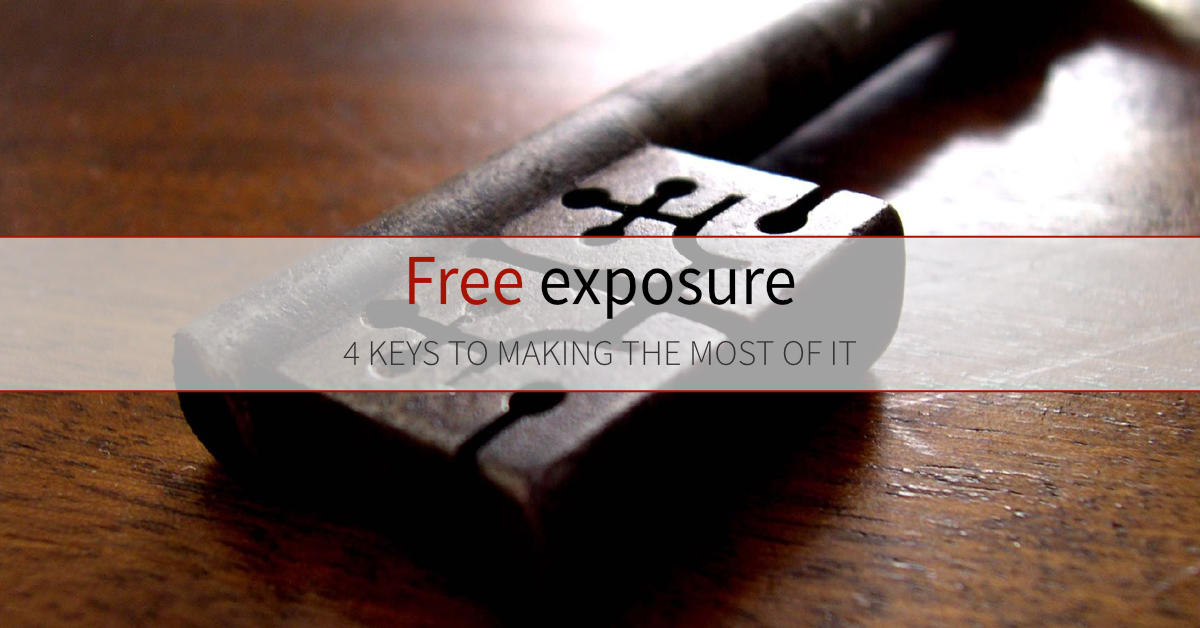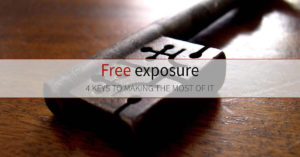
It doesn’t pay anything, but you’ll get good exposure.

I’m not sure who decided that exposure could be good, but venues and promoters have been using this idea as a selling point for a long time now.
The problem is that too often you play these gigs for “exposure” but the paying gigs never come along. You get left out in the cold, and you end up with frostbite.
But it’s not really about promoters looking to take advantage of bands. The fact is, that when you’re just getting started, no one knows who you are or what you sound like. Why would a venue or promoter take a risk on an unknown band? I wouldn’t.
So how are you supposed to become known so that they will pay you?
Exposure isn’t the answer.
You do need some good publicity to get attention, but you don’t want the kind of exposure that sends you to the nearest trauma center with frostbite and hypothermia.

For most bands just getting started, these unpaid gigs never lead anywhere … other than to more unpaid gigs. That’s a blind alley you don’t want to be driving the band bus up at 2AM.
There are two reasons these gigs don’t lead anywhere.
1. You don’t build a following
2. You have no way of showing a promoter that you deserve a paying gig
Below, I’ll outline a few key factors to escaping this cul-de-sac of unpaid gigs and avoiding these pitfalls.
1. Play good music
This seems obvious, but I feel I need to say it anyway.
If your music isn’t good, you don’t deserve a paying gig.
And by good, I mean two things.
First, I mean that it is performed well. Practice your craft. Individually, and as an ensemble, you need to hone your skills so that you play better than the jam band they can hear at the country store on Sunday evening.
Yes, I know, some of those jam bands are good. You have to be better. And just because you think you’re good, doesn’t mean you are. You need an honest opinion.
Not your mother’s.
Try asking your spouse.
Just kidding!

But get an honest opinion. If they say you aren’t ready, get back in the wood shed until you are.
Here’s a helpful article on How to Get the Most Out of Your Band Rehearsal in 3 Hours (or Less)
The second part of what I mean by good, is that the songs are interesting and original. This doesn’t mean that every song you perform has to be written by the band. It does mean that you can’t just rehash twelve Flatt & Scruggs tunes and think you’re done.
Sure, do some classics. I think you should. People need to be able to sing along to a few of the songs you do, but if they know every song you do, perhaps better than you do, then you’ve got a problem.
Try looking for one or two songs from outside the bluegrass genre. Del McCoury has done this to good effect, performing songs by Frank Sinatra, Tom Petty, and others.
The point is, make sure you’re picking good material. Again, get an honest opinion on your song choices.
2. Become an entertainer
Performing is about more than technical expertise and good material. It’s about showmanship. Take a look at Dailey & Vincent for a current example of a group that has honed not only their musicianship, but also their performance.
And take a moment to watch this video of the Johnson Mountain Boys to see a historical example of great showmanship.
3. Run it like a business

Now we’re going to talk business. Playing good music with flair is all well and good, but you can’t stop there. This isn’t a Kevin Costner film. Just because you build it, doesn’t mean the fans will come. You’re going to have to work at this.
The first place to start is with your own website. You need to have your own domain name with your own website. I’m going to assume from this point that you do. This isn’t expensive and even if you’re playing music part-time you still need this.
If you need some help, please start with the link in the last paragraph. I’m working on a series of articles presenting a full tutorial on how to set up your own band website for less than $60 a year.
4. Email is the key
The most important key to successfully avoiding “unpaid gig exposure” is email.
For a while, everyone was excited about MySpace, but it was never your space, it was always their space, and now it’s empty space.
Facebook is the current king of social media, and it is important, but it’s not yours. It looks good to have a large Facebook following, but Facebook has changed their algorithms in recent months decreasing the organic reach of your Facebook page, making it harder to make sure all your fans know about your upcoming show.
These reasons, along with the rise of mobile email access, are why email is still the best way to maintain a fanbase.
With email you own the list, and no one is going to change the algorithm and make it impossible to contact your fans.
With email, you can track and know how many people are reading your show notices.
With email, you can talk directly to your fans. And they are your fans. A Facebook “like” is easy to give away. Giving someone your email address is a bigger commitment, and it lets you know the people who have given you their email want to hear from you. They really do “like” your music, and want to come to your show.
Setting up an email list
I won’t go into too much detail about how to set up an email list in this article, but you’ll want to use an email list service. There are several of these around, but Mailchimp is a good place to start.
Mailchimp has several different plans, depending on the size of your list. A free account will let you send up to 12,000 emails to up to 2,000 subscribers, per month. This should be more than enough to get you started. If you have more than 2,000 subscribers, you should be able to afford one of the paid plans.
In short, create your account, create an opt-in form, put it on your website in an obvious and accessible place on the home page. If that sounds daunting, here’s a step-by-step tutorial on how to setup a free email newsletter using Mailchimp.








